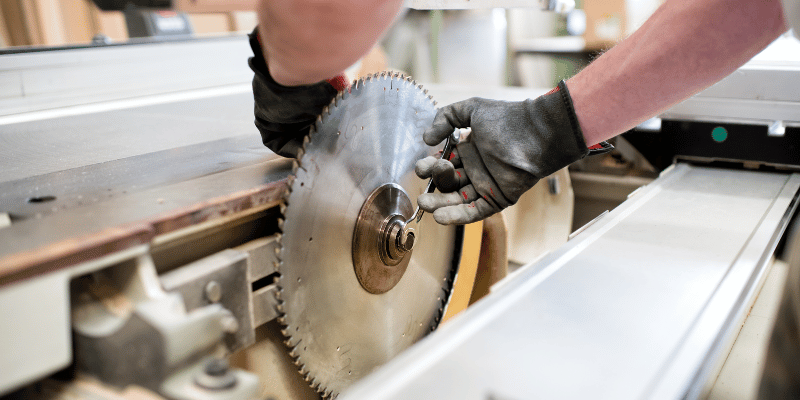To change a circular saw blade, follow these steps:
1. Unplug the saw.
2. Loosen the arbor nut with a wrench. Remove the old blade and replace it with a new one. Tighten the arbor nut securely.
Step-by-step Guide
1. Gather The Necessary Tools And Equipment
Before you start changing the circular saw blade, make sure you have all the required tools and equipment at hand. You will need:
- A wrench or an arbor lock
- Safety goggles
- Gloves
- A clean cloth or rag
- The new circular saw blade
2. Ensure The Saw Is Turned Off And Disconnected
Safety should always be your priority when working with power tools. Before removing the circular saw blade, make sure the saw is turned off and disconnected from the power source. This will prevent any accidental startup or electric shock.
3. Loosen The Blade Guard And Remove Any Debris
To access the blade, you will need to loosen the blade guard. Use a wrench or screwdriver to loosen the screws that secure the blade guard in place. Once loosened, lift the guard and check for any debris or sawdust that may have accumulated. Remove it using a clean cloth or rag.
4. Secure The Saw Blade With A Blade Wrench Or Arbor Lock
To remove the circular saw blade, you will need to secure it. If your saw has a blade wrench, insert it into the blade bolt and use it to secure the blade. Alternatively, if your saw has an arbor lock, engage it to keep the blade in place.
5. Remove The Old Blade And Inspect For Any Damage
Once the blade is secured, use the wrench or arbor lock to rotate the blade bolt counterclockwise. This will loosen the bolt and allow you to remove the old blade. Take a moment to inspect the old blade for any signs of damage or wear. If you notice any issues, it’s a good idea to replace it with a new one.
6. Clean The Blade Mounting Area And Install The New Blade
Before installing the new circular saw blade, take a moment to clean the blade mounting area. Use a clean cloth or rag to wipe away any dirt, debris, or sawdust. Once clean, carefully place the new blade onto the mounting area, making sure it fits securely and aligns with the saw’s arbor.
7. Tighten The Blade Securely And Reattach The Blade Guard
With the new blade in place, use the wrench or arbor lock to tighten the blade bolt clockwise. Make sure the blade is securely fastened to prevent any accidents during operation. Once tightened, reattach the blade guard by securing the screws that were loosened earlier. Ensure the guard is properly aligned and covers the blade completely.
8. Check The Blade Alignment And Make Any Necessary Adjustments
Before testing the circular saw, check the blade alignment. Ensure that the blade is parallel to the saw’s base and doesn’t wobble when spinning. If you notice any misalignment, make the necessary adjustments following the manufacturer’s instructions. Proper alignment is crucial for accurate and safe cutting.
Follow these step-by-step instructions to change the circular saw blade safely and efficiently. By taking the time to gather the necessary tools, ensuring the saw is turned off, and following the proper procedures, you’ll be able to replace the blade with ease and continue your woodworking projects smoothly.
Best Practices For Changing Circular Saw Blades
When it comes to changing circular saw blades, following the best practices ensures not only your safety but also the efficiency and longevity of your tools. In this section, we will discuss the important steps and precautions to take when changing circular saw blades.
Safety Precautions To Follow
To prevent accidents and injuries, it is crucial to adhere to proper safety precautions when changing circular saw blades:
- Always disconnect the saw from the power source before beginning any blade replacement.
- Wear protective gloves and eye goggles to protect your hands and eyes from any potential hazards.
- Ensure the saw is turned off and the blade has come to a complete stop before attempting to replace it.
- Use the proper tools and follow the manufacturer’s instructions for removing and installing the blade.
Choosing The Right Blade For The Job
Each cutting task requires a specific type of blade, so choosing the right one is essential for achieving the best results. Here are a few factors to consider when selecting a circular saw blade:
- Material: Identify the material you will be cutting, such as wood, metal, or masonry, and choose a blade specially designed for that material.
- Tooth Count: The number of teeth on a blade determines its cutting speed and finish quality. Higher tooth count blades produce finer cuts, while lower tooth count blades are suitable for faster, rougher cuts.
- Blade Size: Ensure the blade you choose matches the arbor size as specified by your circular saw’s manual.
Maintaining And Cleaning The Saw Blade
To prolong the life of your circular saw blades and ensure optimal performance, regular maintenance and cleaning are important:
- After each use, remove debris and sawdust from the blade with a brush or compressed air.
- Inspect the blade for any signs of damage, such as missing or dull teeth, and replace it if necessary.
- Use a blade cleaner or a suitable solvent to remove resin or pitch buildup on the blade, following the manufacturer’s instructions.
Tips For Extending The Lifespan Of Your Blades
By taking a few additional steps, you can extend the lifespan of your circular saw blades and maximize their performance:
- Avoid using excessive force when cutting, as it can cause unnecessary strain on the blade and reduce its lifespan.
- Store the blades in a clean and dry environment to prevent rust and damage.
- Use cutting lubricants or wax sticks to reduce friction and heat during extended cutting sessions.
- Rotate the blades periodically to ensure even wear and avoid overusing one particular area of the blade.
Troubleshooting Common Issues
Changing the circular saw blade on your power tool is a basic maintenance task that every woodworker or DIY enthusiast should be familiar with. However, like with any job, you may encounter some common issues along the way that can make the process a bit frustrating. In this section, we will discuss the troubleshooting steps for the most common problems that arise when changing the circular saw blade.
Blade Not Fitting Properly
If you find that the new blade you purchased doesn’t fit properly into your circular saw, there could be a couple of reasons causing this issue. The first thing you will want to check is the size of the blade. Ensure that you have the correct size for your specific saw model. The most common blade sizes are 7 1/4 inches, 6 1/2 inches, and 10 inches.
Another possible reason for the blade not fitting properly is the arbor size. The arbor is the part of the saw where the blade attaches. Different saw models have different arbor sizes, so it is crucial to match the arbor size of the blade with the arbor size of your saw. It’s also essential to ensure the arbor hole is clean and free from any debris that could prevent the blade from fitting snugly.
Difficulty In Loosening/tightening The Blade
If you’re having trouble loosening or tightening the blade, it can be quite frustrating. One common reason for this problem is the blade getting stuck due to rust or debris accumulation. To overcome this issue, you can apply a rust-dissolving spray or use a penetrating oil to lubricate the parts. Let the oil sit for a few minutes before attempting to loosen or tighten the blade again.
Additionally, check if the blade guard is properly retracted before trying to change the blade. Sometimes, the blade guard can interfere with the process, making it difficult to access the blade nut or screw. If necessary, adjust the guard position to make the blade-changing process smoother.
Blade Wobbling Or Vibrating During Use
A circular saw blade that wobbles or vibrates during use is not only annoying but can also compromise the quality of your cuts. One possible reason for this issue is a loose blade nut or screw. Ensure that the blade nut or screw is securely tightened before using the saw. You can use a wrench to ensure a proper tightness, but be cautious not to overtighten, which may damage the blade or the saw.
If the blade is properly tightened, but you still notice excessive vibration, the issue might lie with the blade itself. Blades can become warped or bent over time, affecting their performance. Consider replacing the blade with a new one to eliminate the vibration and achieve smoother cuts.
Uneven Cuts Or Splintering
If you are experiencing uneven cuts or splintering, it can be frustrating after putting in the effort to change the blade. One common reason for this problem is a dull blade. Over time, blades can become dull and lose their sharpness, resulting in poor-quality cuts. Consider sharpening or replacing the blade if it has been used extensively or shows signs of wear and tear.
Another factor to consider is the tooth configuration of the blade. Different blades are designed for specific purposes, such as ripping or cross-cutting. Ensure you are using the appropriate blade for your desired cut. Using the wrong blade type can lead to splintering and rough cuts.
By troubleshooting these common issues, you can ensure a smooth and efficient circular saw blade changing process. Remember to follow safety precautions, such as wearing gloves and disconnecting the power source, before attempting to change the blade to avoid any accidents.

Frequently Asked Questions On How To Change Circular Saw Blade
Which Way Does Circular Saw Blade Go On?
The circular saw blade should go on with the teeth facing forward for maximum cutting efficiency.
Is A Circular Saw Blade Bolt Reverse Thread?
No, a circular saw blade bolt does not have reverse thread.
What Size Wrench Do I Need To Change A Circular Saw Blade?
To change a circular saw blade, you’ll need a wrench. The size of the wrench will depend on the specific model and make of your saw. Refer to the manufacturer’s instructions or check the blade nut size on your saw to determine the correct wrench size for replacement.
How Do You Remove The Pitch From A Circular Saw Blade?
To remove pitch from a circular saw blade, use a cleaning solution and a brush to scrub the blade’s surface. Rinse it with water and dry thoroughly before using. Regular maintenance will help prolong the blade’s lifespan and keep it cutting smoothly.
Conclusion
To recap, changing a circular saw blade is a simple yet crucial task for any woodworking enthusiast. By following the step-by-step process discussed in this blog post, you can ensure the safety and efficiency of your cutting projects. Remember to prioritize safety and carefully adhere to the manufacturer’s instructions.
With regular maintenance and proper blade changes, your circular saw will continue to deliver precise and clean cuts. So, roll up your sleeves and confidently take on any woodworking project that comes your way!


